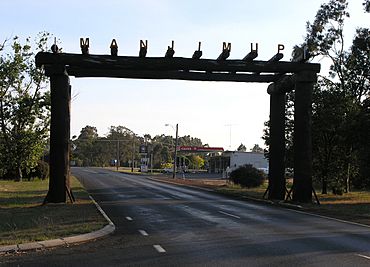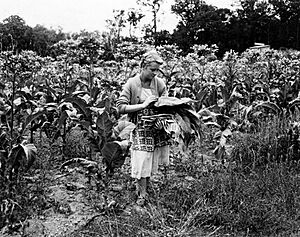Manjimup, Western Australia facts for kids
Quick facts for kids ManjimupWestern Australia |
|||||||||||||||
|---|---|---|---|---|---|---|---|---|---|---|---|---|---|---|---|

Entrance to Manjimup, late afternoon
|
|||||||||||||||
| Established | 1856 | ||||||||||||||
| Postcode(s) | 6258 | ||||||||||||||
| Elevation | 287 m (942 ft) | ||||||||||||||
| Area | [convert: needs a number] | ||||||||||||||
| Location |
|
||||||||||||||
| LGA(s) | Shire of Manjimup | ||||||||||||||
| State electorate(s) | Warren-Blackwood | ||||||||||||||
| Federal Division(s) | O'Connor | ||||||||||||||
|
|||||||||||||||
|
|||||||||||||||
Manjimup is a town in Western Australia. It's about 307 kilometres (191 mi) south of Perth, the state capital. Manjimup is the main town for the biggest local government area in the South West region of Western Australia. In 2016, about 4,349 people lived there.
Contents
Manjimup's Past: A Look at Its History
The name Manjimup comes from the Noongar language. "Manjin" means a broad-leafed plant that people could eat. "-up" means a meeting place or a special spot.
The first person to settle here was Thomas Muir in 1856. He was a timber cutter. Manjimup officially became a town in 1910. A railway line from Perth reached the town in 1911.
After World War I, more people moved to Manjimup. This was part of the Group Settlement Scheme. The idea was to give land to soldiers who had returned from the war. However, the land was hard to clear. Many new settlers were not used to farming. The scheme was not very successful.
Those who stayed became dairy farmers. But this ended during the Great Depression in the 1930s. The price of butterfat dropped too low.
In 1992, Manjimup hosted a big international sporting event. It was the Motocross des Nations. This is like the world cup for motocross racing. It's the only time Australia has hosted this event.
Manjimup's Economy: How the Town Makes Money
Local Industries and Products
Timber has always been a major industry in Manjimup. But now, other things are important too. These include fruit and vegetable farms, dairy farms, wool, grain, and vineyards.
The famous Cripps Pink apple, also known as the Pink Lady, was created here. It was developed in Manjimup in 1973. This was done by John Cripps from the Western Australian Department of Agriculture. The Pink Lady apple is now sold in many countries.
Manjimup used to make frozen French fries. It also had a successful tobacco industry. But this ended in the 1960s. Today, Manjimup exports things like marri wood flooring. Apples are sent mainly to India. Spring water is exported to Saudi Arabia, Singapore, and India.
Manjimup is the top producer of black truffles on the Australian mainland. Truffles are a special type of mushroom that grows underground. Scientists are studying how to grow more truffles here. They work with universities in Western Australia. The government gives money for this research. Manjimup's weather is similar to places in France that grow truffles. Manjimup truffles are sold to restaurants in big Australian cities. Restaurants in France and Germany have also asked for samples.
Scientists are also researching green tea production. The Department of Agriculture and Food is working on this. Experts from Japan think Manjimup is a good place for green tea. They like its climate, clean image, good soil, and rainfall. The Manjimup/Pemberton area is similar to a main tea-growing area in Japan. It has similar soil and average temperatures. They are testing ten types of green tea to see which grows best.
Fun Things to Do: Tourism in Manjimup
Manjimup has many interesting places to visit.
- The Diamond Tree is a tall fire lookout tree.
- The Four Aces are four huge karri trees. They are 75-metre-tall (246 ft) and over 400 years old.
- One Tree Bridge is a bridge made from a single karri tree.
- Fonty's Pool is a popular swimming spot.
- The Manjimup Timber Park is a museum about timber.
- You can also visit timber sawmills like Deanmill.
During wildflower season (October to December), the King Jarrah Heritage Trail is beautiful. You can see many native flowers there.
Since 2001, Manjimup has held an annual cherry festival in December. This three-day festival is very popular. It includes crowning a cherry king and queen. There's also a fun cherry pit spitting competition! About 5,000 visitors come to the festival.
In 1980, Manjimup started its first motocross event. It was called the Manjimup 15000 International Motocross. This was because the first-place prize was $15,000. The event happened every June. It stopped in 2006 due to insurance problems and not enough volunteers. In 2005, 6,000 people watched the event. There were 340 racers from Australia, New Zealand, and the United States. The event started again in 2009.
The Manjimup Heritage Park was chosen as Western Australia's joint Favorite Playground in 2021.
Learning in Manjimup: Schools and Education
Manjimup has two public primary schools and one public high school. There is also a Catholic school called Kearnan College. It teaches students from kindergarten to Year 12.
Manjimup Primary School opened in 1911. It moved to a new building in 2005. In 2007, it had 431 students. Most students stay in Manjimup for high school.
East Manjimup Primary School opened in 1971. Most of its students live in the eastern part of town. In 2007, it had 331 students.
Kearnan College was started by the Sisters of St Joseph of the Sacred Heart in 1925. It was first called St Joseph's. In 2016, it had 461 students. It started as only a primary school. The high school part was added in 1970. This made Kearnan College the first coeducational Catholic school in Western Australia. This means both boys and girls could attend.
The town's high school is Manjimup Senior High School. It was built in 1957. The school has been updated several times. More than half of its students travel to school by bus. Some students travel over 80 kilometres (50 mi) (50 miles) each way every day. The school serves students from Manjimup and nearby towns. These include Bridgetown, Northcliffe, Pemberton, and Boyup Brook.
In 2007, Manjimup Senior High School had 668 students. The school works with colleges and universities. It often does well in Tertiary Entrance Exam results. In 2007, it was the best-performing public school in Western Australia.
Getting Around: Transportation in Manjimup
The railway line reached Manjimup in 1911. It was finished in June 1913. Trains carried people and timber from the sawmills. Passenger train services stopped in 1969. A new station was built for road service passengers and freight. The rail yards closed in 1997. They were turned into the Manji Park tourism area in 2003.
Most people in Manjimup use cars to get around. In 2006, 91% of people going to work drove or were passengers in cars. Walking was the next most popular way, at 4.5%.
The Manjimup Volunteer and Resource Centre has a community bus service. It mainly helps young people, seniors, and people with disabilities. The Public Transport Authority also arranges school bus services.
You can travel between Perth and Manjimup by Transwa bus. There are also bus services via Bunbury. You can also take the daily Australind train for part of the journey. South West Coach Lines also travels between Perth and Manjimup on weekdays.
Manjimup's Weather: Climate Information
Manjimup has a mild Mediterranean climate. This means it has cool, wet winters and warm, dry summers.
The longest time Manjimup had cold days in a row was 20 days. This was from July 13 to August 1, 1958. The longest time it rained without stopping was 44 days. This was from July 1 to August 13, 1946. During that time, 374 millimetres (14.7 in) (14.7 inches) of rain fell.
| Climate data for Manjimup, Western Australia (inland) | |||||||||||||
|---|---|---|---|---|---|---|---|---|---|---|---|---|---|
| Month | Jan | Feb | Mar | Apr | May | Jun | Jul | Aug | Sep | Oct | Nov | Dec | Year |
| Record high °C (°F) | 42.7 (108.9) |
41.6 (106.9) |
41.2 (106.2) |
34.4 (93.9) |
29.2 (84.6) |
22.9 (73.2) |
21.6 (70.9) |
24.6 (76.3) |
30.4 (86.7) |
33.3 (91.9) |
38.7 (101.7) |
41.1 (106.0) |
42.7 (108.9) |
| Mean daily maximum °C (°F) | 27.2 (81.0) |
27.1 (80.8) |
24.2 (75.6) |
21.1 (70.0) |
17.7 (63.9) |
15.4 (59.7) |
14.4 (57.9) |
15.1 (59.2) |
16.5 (61.7) |
18.9 (66.0) |
22.0 (71.6) |
24.9 (76.8) |
20.4 (68.7) |
| Mean daily minimum °C (°F) | 13.1 (55.6) |
13.4 (56.1) |
12.5 (54.5) |
10.8 (51.4) |
8.9 (48.0) |
7.5 (45.5) |
6.4 (43.5) |
6.5 (43.7) |
7.2 (45.0) |
8.3 (46.9) |
10.1 (50.2) |
11.7 (53.1) |
9.7 (49.5) |
| Record low °C (°F) | 6.0 (42.8) |
5.6 (42.1) |
3.3 (37.9) |
1.6 (34.9) |
−0.6 (30.9) |
0.2 (32.4) |
−0.6 (30.9) |
0.0 (32.0) |
0.6 (33.1) |
0.1 (32.2) |
2.3 (36.1) |
4.4 (39.9) |
−0.6 (30.9) |
| Average precipitation mm (inches) | 20.0 (0.79) |
18.6 (0.73) |
29.9 (1.18) |
59.5 (2.34) |
129.2 (5.09) |
161.6 (6.36) |
174.1 (6.85) |
145.0 (5.71) |
108.9 (4.29) |
75.1 (2.96) |
46.1 (1.81) |
25.3 (1.00) |
994.2 (39.14) |
| Average precipitation days | 5.9 | 5.9 | 7.6 | 11.6 | 17.6 | 20.1 | 22.3 | 21.0 | 17.7 | 15.1 | 10.5 | 7.3 | 162.6 |
| Average afternoon relative humidity (%) (at 1500) | 43 | 44 | 48 | 58 | 65 | 71 | 71 | 68 | 64 | 57 | 51 | 47 | 57 |
Famous People from Manjimup
Many well-known people have connections to Manjimup:
- Piero Balbo (1916–2003) was a lawyer. He led Italian partisan groups from 1943 to 1945. He was born in Manjimup.
- John Chester was involved in environmental activism.
- Walter Handmer AM (1927–2007) was an Australian diplomat. He lived in Manjimup from the early 1930s until 1944.
- Sam Kekovich (born 1950) is a former Australian rules footballer. He played for North Melbourne and Collingwood. He was born in Manjimup.
- Shelly Liddelow (born 1984) is an Olympic field hockey player. She was born in Manjimup.
- Marlion Pickett (born 1992) is an Australian rules footballer. He plays for the Richmond Football Club in the AFL. He was born in Manjimup.
- Matt Priddis (born 1985) is a former Australian rules footballer. He won the Brownlow Medal and played for the West Coast Eagles. He was born in Manjimup.





